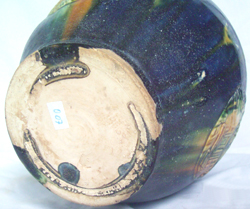|

The
Story of
Sancai
Ceramics
The Sancai
(meaning
three-colour) Porcelain style was predominant during the Tang dynasty (618 - 911). Its main origins are in northern China, in areas such as
Chang'an, Shaanxi Province, and Loyang, Henan Province.
Sancai Ceramics are created in a wide range of decorative forms often with bright
colours. Because of the style's liberal use of green, yellow and white, Sancai is sometimes called egg-and-spinach in the west. In earlier times,
the ceramic style did not attract collectors since almost all of the pieces were originally burial objects. Today,
most people appreciate the intense creativity of the ancient Sancai
potters.
The Sancai technique used a low-temperature glazing and white clay, and later finishing pieces by firing at
a temperature around 800C. Figures such as horses were formed by moulding and adding white clay. Glazes on Sancai pieces often flowed downward during firing and colours
commonly appear uneven.
|
Blue Vase with Animal Figures
CERAMIC ARTIFACT #ta-000708
DESCRIPTION:
The
vase has attractive animal shapes and medallions that were pasted on the
clay body coloured in a typical Sancai manner (green, yellow,
white). However, the main body is blue which is unusual for this
era. Therefore, more research is required to confirm this
origination of this piece.
ORIGIN:
The
artifact was produced in northern China, in areas such as Chang'an, Shaanxi Province, and
Loyang, Henan Province.
It was brought to Southeast Asia as a trade-good probably by an ancient Chinese trading
ship and sold among one of
the many thriving Chinese communities living in Southeast Asia. The object probably ended up as a burial
object of a prominent individual.
Centuries later, it was rediscovered by excavators and subsequently acquired by The Chalre Collection through a registered dealer.
AGE:
Produced
in the Tang
Dynasty (618 - 907).
MEASUREMENTS:
Height:
27cm (10.5in.)
Width
or Depth: 22cm (8.75in.)
REFERENCES:
Artifacts
with similar or identical shape and/or decorations are found in various
publications including: Chinese
Ceramics, The
Art of Chinese Ceramics and other publications dealing with Tang era
pottery styles.
Similar
and/or identical items are also on display at the Victoria & Albert
Museum in London (UK), the Asian Art Museum in San Francisco (USA), the
National Museum of Malaysia (Kuala Lumpur), the National Museum of the
Philippines (Manila) and other museums throughout the world with diverse
collections of Asian ceramics.
Specific
references will be provided at a later phase of this site's development.

|